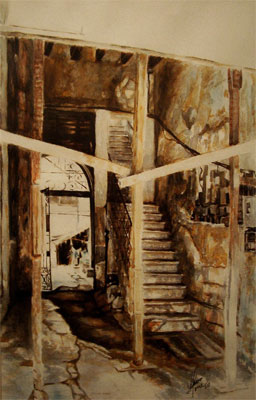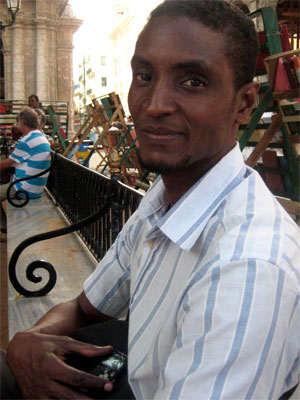Between the Brush, the Sword and the Light
Yusimi Rodriguez

HAVANA TIMES — A friend invited me to the opening of the exhibition “En el fondo hay luz” (In the Background There’s Light), last month at the Arte Facto Gallery, coinciding with the 493th anniversary of the founding of Havana.
“He’s not a well-known painter,” he said, “but the artist’s work is very interesting. He does cityscapes in watercolors.” This made me think old cars and views of the Capitolio Building or the Cathedral. However his work is of “ruins,” explained my friend, “shored up buildings, structures virtually destroyed.” In other words, the most visible sights in Havana.
The name of the artist — Cesar Towie — didn’t mean anything to me, but the physical description of him did. It turned out that I knew him as a martial artist, the president of the Cuban Aikido School.
HT: What came first in your life, the brush or the sword?
Towie: As a child I took up judo. In the second year of my training I started taking Aikido. I began learning about Japanese culture and became interested in the philosophy of Zen Buddhism. Then I started practicing with swords; first the Kendo and later the Iaido, in 1997. In 1998, a teacher of that school came here from Japan for the first time. When he decided to start his school here, I was one of the members. The others gradually left so I remained in charge of the school.
HT: Yesterday I asked if you were practicing Japanese calligraphy, and if there’s any connection with the fact that your works are in watercolors on cardboard and not in oil on canvas, though those latter sell the most.
Towie: Working with watercolor occurred by accident. It was the medium that was within my reach. In 1997 I graduated from the Faculty of Artistic Education, at Ciudad Libertad, as a mid-level design specialist, and in design we were trained to work on paper.
HT: But in the artistic education faculty they also trained you to work with oil or acrylic on canvas.

Towie: Yes, but those materials were scarce when I was studying. That doesn’t mean I can’t work in those media or with those materials; I’ve done it, especially with acrylic. But at that time, watercolor was what I had on hand. I even started making my own paper because it wasn’t easy to find watercolor paper. Gradually I began to master that medium. There are still some things I lack; I don’t think I’ve reached my ideal. But like you say, as I got into Japanese culture more, I became interested in paper because I liked calligraphy as an effect.
The Japanese don’t distinguish between calligraphy and painting on cardboard. What you would consider as distinctly painting, that which involves watercolor, for them is distinctly writing. They don’t work on cardboard, but on rice paper. There they do calligraphy, but in the great museums of Japanese art you’ll see great works of drawing using ink on the same paper. Japanese characters are essentially ideograms, synthesized drawings.
HT: Is it Japanese or Chinese? I understand that the Japanese borrowed from the Chinese alphabet.
Towie: Yes. The Chinese used to do ink drawing in that same sense. Japan took that cultural heritage from the Chinese.
What also began to catch my attention was how I was interacting with Japanese culture. I was identifying with Buddhist philosophy, which speaks to the ephemeral, the beautiful and the transcendent of a moment. Working with paper represents impermanence compared to other materials.
HT: Is work on cardboard more likely to be destroyed?
Towie: Naturally. That’s why many collectors aren’t interested in it as much as oil.

At some point I asked myself those same questions, but we ourselves are all going to disappear at some point. So why then cling so forcefully to having something that will endure if in one way or another, sooner or later, it’s going to disappear? Why not work on what one considers the ideal of beauty, even if it’s in a medium that isn’t as durable as others? Though if something is well maintained, it can last for a long time. I learned what paper to use and what paint to use so that my work wouldn’t eventually oxidize. But there’s a factor I can’t control, that is going to ultimately happen in one way or another.
HT: What made you seek beauty in these “ruins” that we constantly see here in Havana, though they don’t appear in tourism magazines, the media or in soap operas?
Towie: It’s a process. When preparing my thesis at the university, I had to create a visual map of a place. I was given Centro Habana. The goal was for high school students who were studying artistic education to know the important elements of their city from a visual perspective. That included architecture. I had to study the different architectural styles and features. I was learning my city, going into places I’d never been before. I discovered very interesting aspects in things previously ignored, only now with a better trained eye.
I started working on general elements of the urban landscape. But I returned to the philosophy of Buddhism, and the title of the exhibit, “In the Background There’s Light,” for the beauty that can be possessed by what is apparently destroyed, what’s marginal. I’m calling on people to look at things with more compassion, with more caring. It’s said that everyone has a Buddha within; here I’m trying to talk with the Buddha within these places.
HT: I noticed that although you always show signs that these ruins were once inhabited, there’s never any human presence.

Towie: People have asked me that before. I could have drawn them, but the idea is for each viewer to feel like they’re inside the painting, alone with that space, reflecting according to their interpretation and their way of seeing the city or that corner.
HT: Do you live in a home that’s in sub-standard condition, one that’s braced up?
Towie: No, but places in those conditions surround me. I have friends who live like that. It’s also a nostalgic song about what it was and what its becoming, but it’s also about the beauty that’s being left. It’s a beauty that’s dying, but it’s still interesting.
HT: Do you work from photos?
Towie: Yes. Sometimes I take notes with a fair amount of detail, and then I work on it at home.
HT: But you’re not interested in exhibiting the photographs.
Towie: No. I’m interested in the decomposition of the brush stroke, in people being able to see different overlapping strokes and the ways that water has to express itself. I try to decompose things to show that the world is illusory, that behind what we see is empty. At first sight, photographs are more concrete, while watercolors open up more spaces.
HT: Do you think that at some point these ruins will become themes that are as commercial as old cars, ‘mulatas,’ and people smoking cigars?

Towie: That could be a danger. It depends on how one looks at themself and what they want to convey, whether it’s real beauty or on the surface. In my case, I want to go deeper.
On the relationship between my work and Japanese calligraphy, I need to say that although I know calligraphy, I’m not a serious practitioner of it. But Iaido is a kind of calligraphy in the air. In fact, the translation in the West is “drawing with a sword.” My quest is to try and learn to unravel the relationship between the movement of the sword and the watercolor brush.
HT: Isn’t Iaido a martial art for combat?
Towie: It was. These days, though, it’s not used combat.
HT: What does a practitioner of Iaido seek these days?
Towie: AIaido is called the Zen of the martial arts. The practitioner seeks to find themself, like other martial arts. The sword and scabbard are the instruments. The sword represents the soul and the scabbard the body. The training seeks perfection of those things that simultaneously align with the universe. AIaido means the way to exist in harmony. Previously, AIaido was the art of cutting while unsheathing, but over time it became more spiritual. Now it seeks to cut its own ego.
Towie showed me one of the Japanese brushes he works with. Sometimes he one uses only one throughout a watercolor. “Like a single sword,” he explains.
Towie: This was given to me by my sword teacher for doing calligraphy. In Japan it’s used for Sumi-e painting. In antiquity it was used for watery monochromes and representing spiritual themes, great scenery, nothingness. It was in contrast to the Ukiyo-e, which was for color and representing the common themes of life, what they call the floating world, the illusory.
HT: Would you say that your watercolor is probably between these two art forms?
Towie: Maybe. I’m trying to search within the illusory world for what’s reflexive, for what’s enduring for what’s truly luminous.
—–
Cesar Tomas Towie Cuestas was born in Havana in 1971. He graduated in artistic education (visual arts) and as a mid-level technician in design. He realized four one-person exhibits between 2002 and 2012, and he has participated in several collective and other events. In 2004, he won the award for Best Stand Award for “El Cafe” at the International Crafts Fair (FIART).
Click on the thumbnails below to view all the photos in this gallery. On your PC or laptop, you can use the directional arrows on the keyboard to move within the gallery. On cell phones use the keys on the screen.























Such beautiful, tragic paintings and a very interesting interview. Thank you!